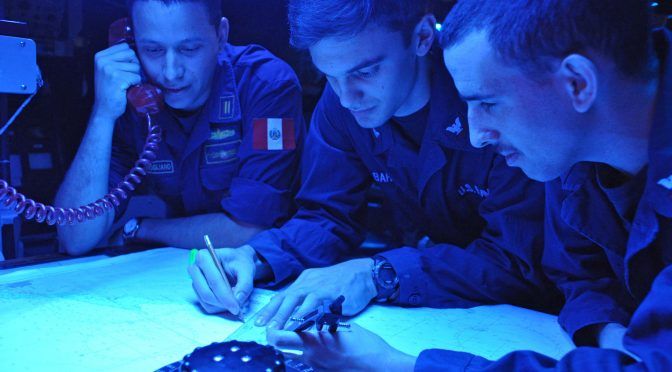
Navy: No Release of UFO Information to the General Public Expected
by Paul Sonne May 1, 2019 (washingtonpost.com)
• In recent news, it was revealed that the U.S. Navy has drafted a procedure to investigate and catalogue reports of unidentified flying objects coming in from its pilots. (see article on new Navy UFO guidelines here) But the service doesn’t expect to make the information public, citing privileged and classified reporting that is typically included in such files.
• Joe Gradisher, a spokesman for the office of the Deputy Chief of Naval Operations for Information Warfare, said in a statement that the Navy expects to keep the information it gathers private for a number of reasons. “Military aviation safety organizations always retain reporting of hazards to aviation as privileged information in order to preserve the free and honest prioritization and discussion of safety among aircrew,” Gradisher said. “Furthermore, any report generated as a result of these investigations will, by necessity, include classified information on military operations.” “Therefore, no release of information to the general public is expected.”
• The Navy’s new UFO reporting guidelines follow the revelation that in late 2017 the Pentagon ran a secret, 5-year, $22M “UFO” office to collect and analyze “anomalous aerospace threats”. It was known as the Advanced Aerospace Threat Identification Program. The program resulted in the release of video footage from the cockpit cameras of Navy aircraft, which appeared to document oval-shaped vessels that resemble flying Tic Tacs. (see NY Times article from Dec 2017 here)
• Reports of curious sightings from military aircraft aren’t new. During World War II, Allied military pilots witnessed unexplained objects and fireballs that they dubbed “foo fighters”. A number of official government investigations looked into such phenomena during the postwar period.
• Even though the Navy has indicated it has no plans to release any UFO data, unclassified portions of the information or broad overviews of the findings could come out, according to Luis Elizondo, an intelligence officer who ran AATIP before leaving the Pentagon. “If it remains strictly within classified channels, then the ‘right person’ may not actually get the information. The right person doesn’t necessarily mean a military leader. It can be a lawmaker. It can be a whole host of different individuals,” Elizondo said. Even if the information isn’t made available to the public, it could be reported to Congress.
The U.S. Navy has drafted a procedure to investigate and catalogue reports of unidentified flying objects coming in from its pilots. But the service doesn’t expect to make the information public, citing privileged and classified reporting that is typically included in such files.
Joe Gradisher, a spokesman for the office of the Deputy Chief of Naval Operations for Information Warfare, said in a statement that the Navy expects to keep the information it gathers private for a number of reasons.
“Military aviation safety organizations always retain reporting of hazards to aviation as privileged information in order to preserve the free and honest prioritization and discussion of safety among aircrew,” Gradisher said. “Furthermore, any report generated as a result of these investigations will, by necessity, include classified information on military operations.”
He added, “Therefore, no release of information to the general public is expected.”
The Navy’s recent decision to draft formal guidelines for pilots to document encounters with unexplained aerial phenomena comes after the revelation in late 2017 that the Pentagon ran a secret “UFO” office that spent $22 million over five years to collect and analyze “anomalous aerospace threats.” Funding for the office, known as the Advanced Aerospace Threat Identification Program, or AATIP, officially ended in 2012, though operations continued.
Among other things, the program resulted in the release of footage from the cockpit cameras of military aircraft, which appeared to document oval-shaped vessels that resemble flying Tic Tacs.
Reports of curious sightings from military aircraft aren’t new. During World War II, Allied military pilots witnessed unexplained objects and fireballs that they dubbed “foo fighters”— a term that later inspired the name of the eponymous 1990s rock band. A number of official government investigations looked into such phenomena in the postwar period.
Now, the Navy has agreed to a more formalized process for cataloguing and investigating reports from pilots, a decision welcomed by former U.S. officials who want the military to take the matter seriously and remove the stigma in the armed forces of reporting such incidents.
Even though the Navy indicated it has no plans in the imminent future to release the data, unclassified portions of the information or broad overviews of the findings could come out, according to Luis Elizondo, an intelligence officer who ran AATIP before leaving the Pentagon.
FAIR USE NOTICE: This page contains copyrighted material the use of which has not been specifically authorized by the copyright owner. ExoNews.org distributes this material for the purpose of news reporting, educational research, comment and criticism, constituting Fair Use under 17 U.S.C § 107. Please contact the Editor at ExoNews with any copyright issue.
Advanced Aerospace Threat Identification Program, Congress, foo fighters, Joe Gradisher, Luis Elizondo, Pentagon, U.S. Navy, UFO reporting guidelines, World War II